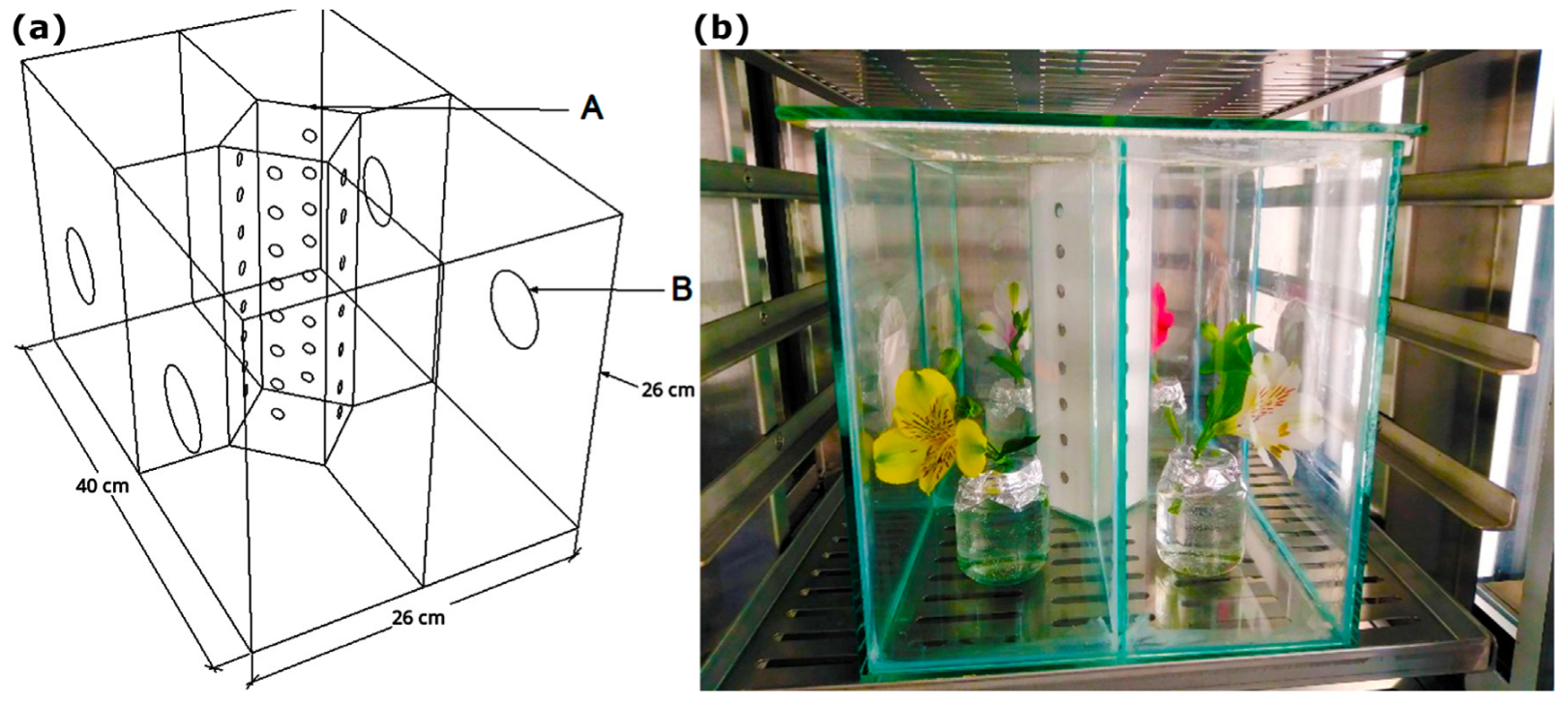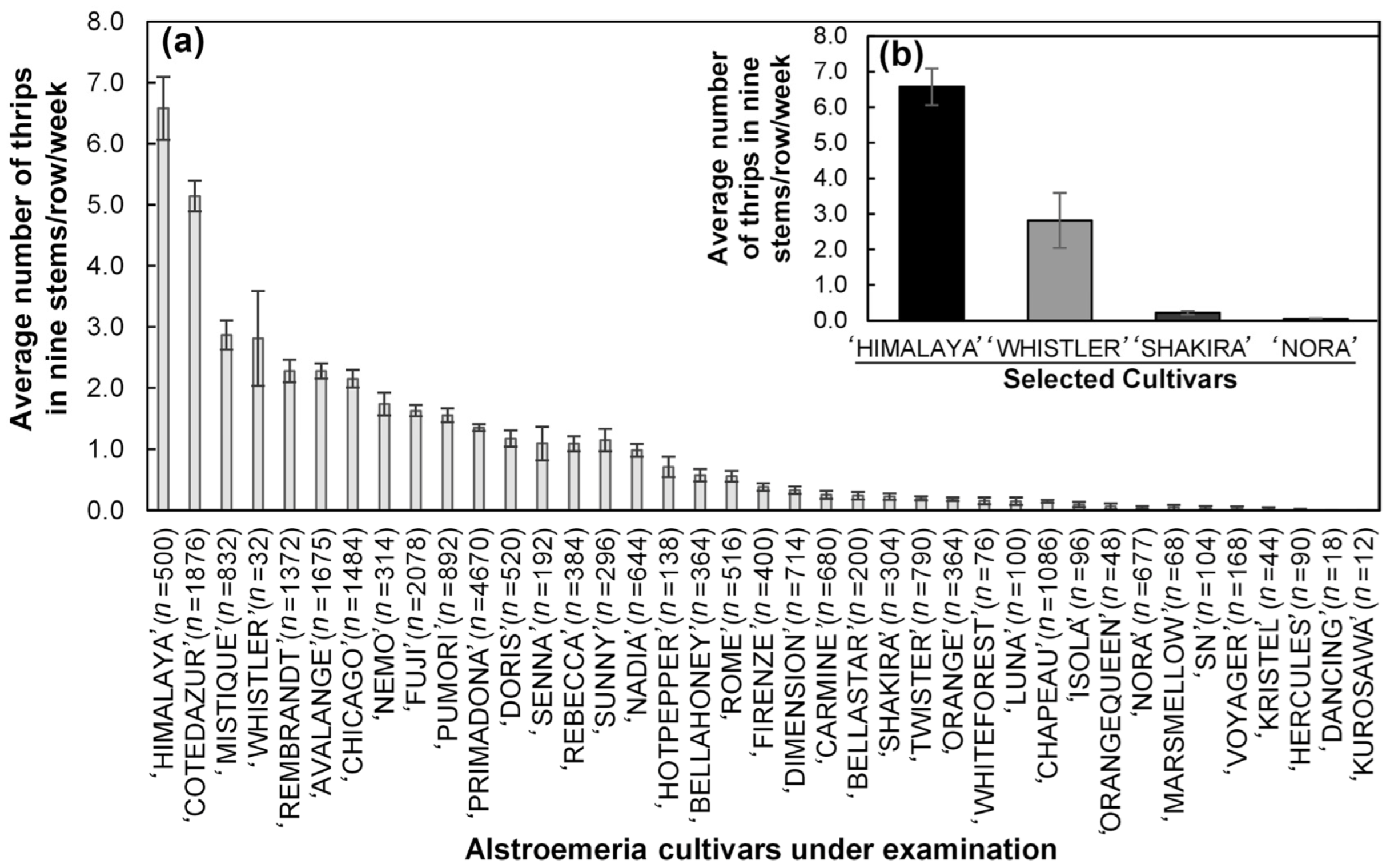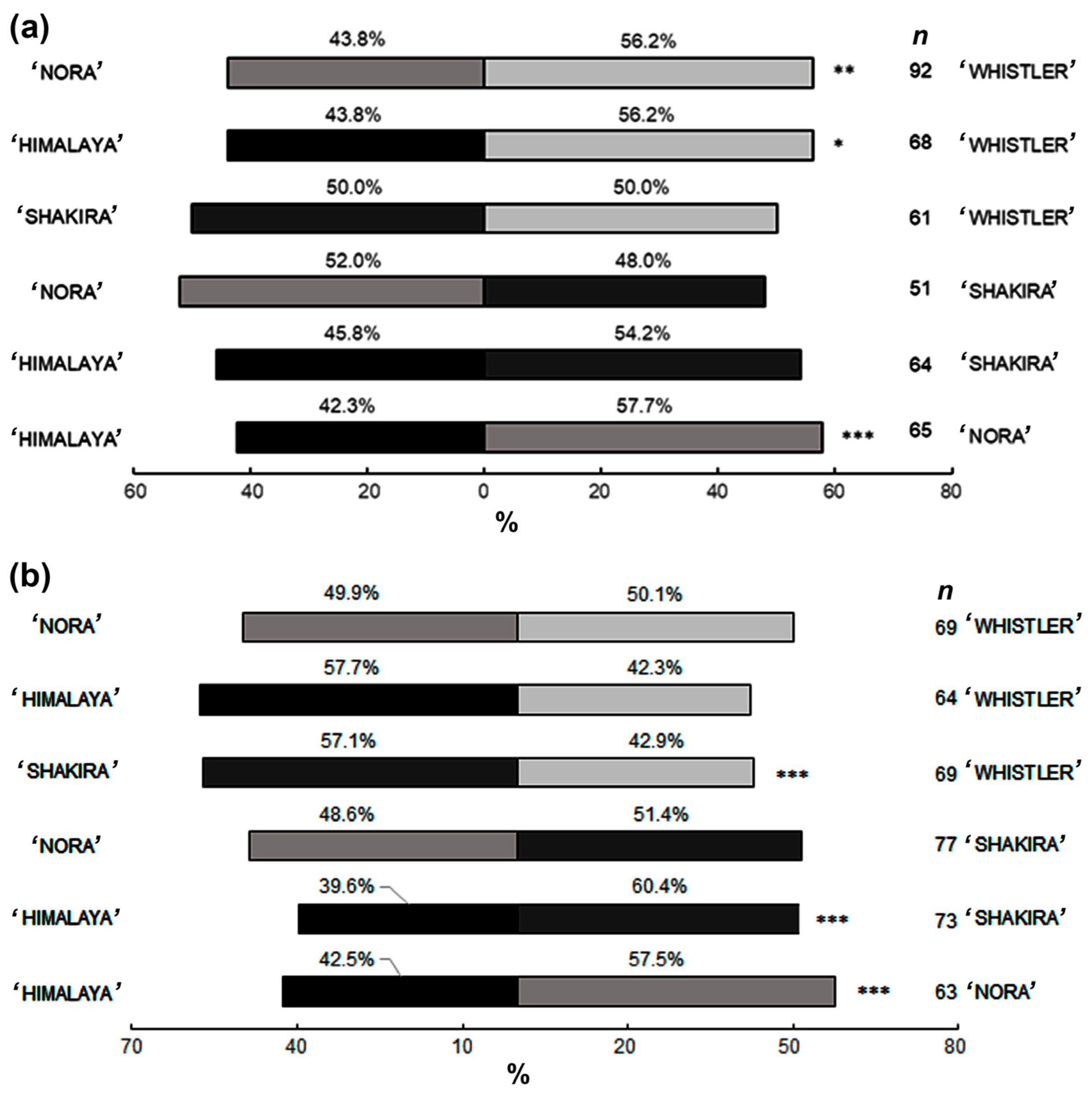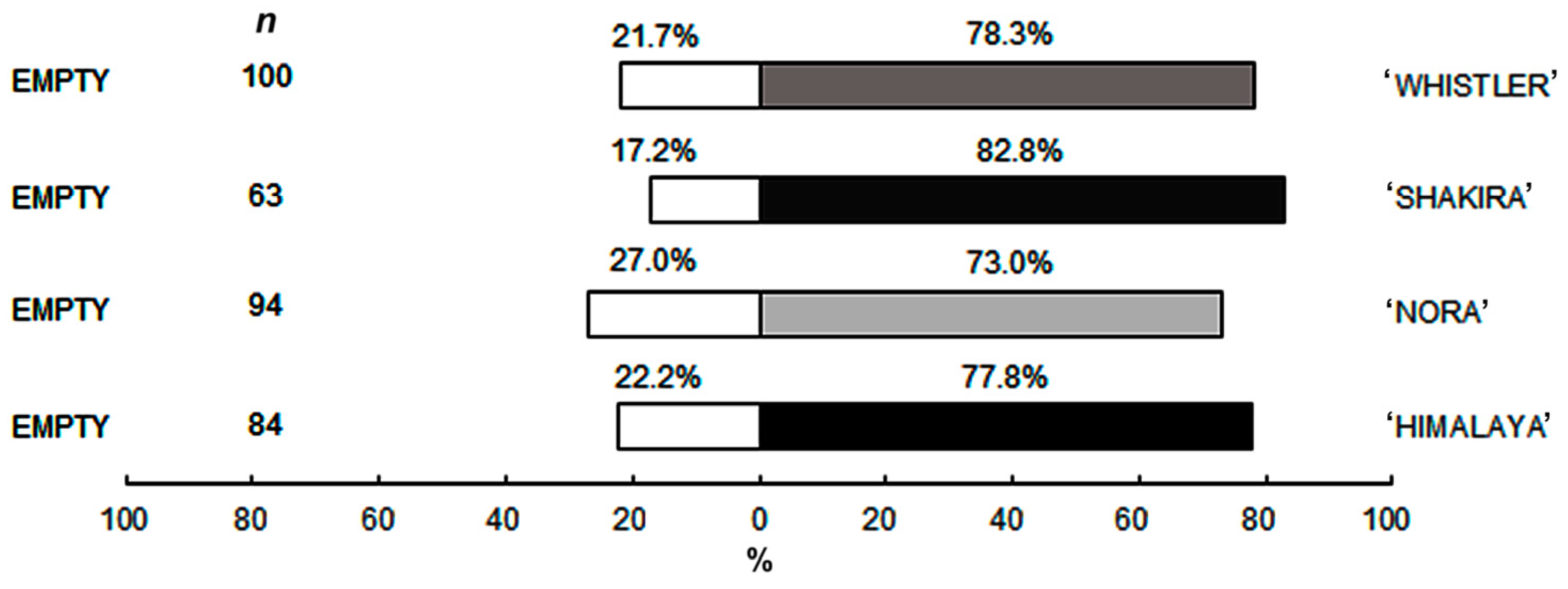Influence of Cultivar-Dependent Alstroemeria Floral Emissions on Frankliniella occidentalis Host Selection Behavior
Abstract
1. Introduction
2. Materials and Methods
2.1. Selection of Cultivars with High and Low WFT Occurrence from Greenhouse Monitoring
2.2. Plants
2.3. Insects
2.4. Behavioral Bioassays
2.4.1. Choice Bioassays
2.4.2. Non-Choice Bioassay
2.4.3. Repellency Bioassay
2.5. Statical Analysis
3. Results
3.1. Occurrence of WFT in Alstroemeria under Greenhouse Conditions
3.2. Behavioral Bioassays
3.2.1. Choice Bioassays
3.2.2. Non-Choice Bioassay
3.2.3. Repellency Bioassay
4. Discussion
5. Conclusions
Supplementary Materials
Author Contributions
Funding
Data Availability Statement
Acknowledgments
Conflicts of Interest
References
- Bridgen, M.P. Alstroemeria. In Ornamental Crops; Van Huylenbroeck, J., Ed.; Springer International Publishing: Riverhead, NY, USA, 2018; Volume 11, pp. 231–236. ISBN 978-3-319-90697-3. [Google Scholar]
- Gaum, W.G.; Giliomee, J.H.; Pringle, K.L. Resistance of Some Rose Cultivars to the Western Flower Thrips, Frankliniella occidentalis (Thysanoptera: Thripidae). Bull. Entomol. Res. 1994, 84, 487–492. [Google Scholar] [CrossRef]
- Jones, D.R. Plant Viruses Transmitted by Thrips. Eur. J. Plant Pathol. 2005, 113, 119–157. [Google Scholar] [CrossRef]
- Macharia, I.; Backhouse, D.; Wu, S.-B.; Ateka, E.M. Weed Species in Tomato Production and Their Role as Alternate Hosts of Tomato Spotted Wilt Virus and Its Vector Frankliniella occidentalis. Ann. Appl. Biol. 2016, 169, 224–235. [Google Scholar] [CrossRef]
- Park, J.D.; Kim, S.G.; Kim, D.I.; Cho, K. Population Dynamics of Frankliniella occidentalis on Different Rose Cultivars and Flowering Stages. J. Asia-Pac. Entomol. 2002, 5, 97–102. [Google Scholar] [CrossRef]
- Buggs, R.; Coker, T.; Denis, C.; Walker, D.; Smith, J.; Mota-Sanchez, D.; Cock, M. Plant Health—State of Research. In State of the World’s Plants; Willis, K.J., Ed.; Royal Botanic Gardens: London, UK, 2017; pp. 64–71. [Google Scholar]
- Carrizo, P.I.; Klasman, R. Frankliniella occidentalis preference for carnation varieties. Bol. Sanid. Veg. Plagas 2003, 29, 201–210. [Google Scholar]
- Katayama, H. Effect of Temperature on Development and Oviposition of Western Flower Thrips Frankliniella occidentalis (Pergande). Jpn. J. Appl. Entomol. Zool. 1997, 41, 225–231. [Google Scholar] [CrossRef]
- Olatinwo, R.O.; Prabha, T.; Paz, J.O.; Riley, D.G.; Hoogenboom, G. The Weather Research and Forecasting (WRF) Model: Application in Prediction of TSWV-Vectors Populations. J. Appl. Entomol. 2011, 135, 81–90. [Google Scholar] [CrossRef]
- Yudin, L.S.; Tabahnik, B.E.; Mitchell, W.C.; Cho, J.J. Effects of Mechanical Barriers on Distribution of Thrips (Thysanoptera: Thripidae) in Lettuce. J. Econ. Entomol. 1991, 84, 136–139. [Google Scholar] [CrossRef]
- McDonald, J.R.; Bale, J.S.; Walters, K.F.A. Effect of Temperature on Development of the Western Flower Thrips, Frankliniella occidentalis (Thysanoptera: Thripidae). EJE 1998, 95, 301–306. [Google Scholar]
- Wang, Z.; Xu, D.; Liao, W.; Xu, Y.; Zhuo, Z. Predicting the Current and Future Distributions of Frankliniella occidentalis (Pergande) Based on the MaxEnt Species Distribution Model. Insects 2023, 14, 458. [Google Scholar] [CrossRef]
- Steiner, M.Y.; Spohr, L.J.; Goodwin, S. Relative Humidity Controls Pupation Success and Dropping Behaviour of Western Flower Thrips, Frankliniella occidentalis (Pergande) (Thysanoptera: Thripidae). Aust. J. Entomol. 2011, 50, 179–186. [Google Scholar] [CrossRef]
- Shipp, J.L.; Gillespie, T.J. Influence of Temperature and Water Vapor Pressure Deficit on Survival of Frankliniella occidentalis (Thysanoptera: Thripidae). Environ. Entomol. 1993, 22, 726–732. [Google Scholar] [CrossRef]
- Arévalo, H.A.; Liburd, O.E. Horizontal and Vertical Distribution of Flower Thrips in Southern Highbush and Rabbiteye Blueberry Plantings, with Notes on a New Sampling Method for Thrips Inside Blueberry Flowers. J. Econ. Entomol. 2007, 100, 1622–1632. [Google Scholar] [CrossRef] [PubMed]
- Cloyd, R.A. Western Flower Thrips (Frankliniella occidentalis) Management on Ornamental Crops Grown in Greenhouses: Have We Reached an Impasse? Pest Technol. 2009, 3, 1–9. [Google Scholar]
- Cloyd, R.A. Indirect Effects of Pesticides on Natural Enemies. In Pesticides–Advances in Chemical and Botanical Pesticides; Soundararajan, R.P., Ed.; IntechOpen: Rijeka, Croati, 2012; pp. 127–150. [Google Scholar]
- Avellaneda, J.; Díaz, M.; Coy-Barrera, E.; Rodríguez, D. Incidence and Preference of Frankliniella occidentalis (Thysanoptera:Thripidae) to Diferent Rose Cultivars. Arthropod Plant Interact. 2022, 16, 205–214. [Google Scholar] [CrossRef]
- Rodríguez, D.; Coy-Barrera, E. Overview of Updated Control Tactics for Western Flower Thrips. Insects 2023, 14, 649. [Google Scholar] [CrossRef]
- Durán, D. Agronomic Current Notes: Cultivating Alstroemerias; Metroflor: Norwalk, CT, USA, 2018; pp. 71–73. [Google Scholar]
- Wagstaff, C.; Bramke, I.; Breeze, E.; Thomas, B.; Buchanan-Wollaston, V.; Harrison, L.; Rogers, H.; Stead, T. Global Changes in Gene Expression during Alstroemeria Petal Senescence. Acta Hortic. 2005, 669, 127–134. [Google Scholar] [CrossRef]
- Aros, D.; Gonzalez, V.; Allemann, R.K.; Müller, C.T.; Rosati, C.; Rogers, H.J. Volatile Emissions of Scented Alstroemeria Genotypes Are Dominated by Terpenes, and a Myrcene Synthase Gene Is Highly Expressed in Scented Alstroemeria Flowers. J. Exp. Bot. 2012, 63, 2739–2752. [Google Scholar] [CrossRef]
- Aros, D.; Rogers, H.J.; Rosati, C. Floral Scent Evaluation in Alstroemeria through Gas Chromatography-Mass Spectrometry (GC-MS) and Semiquantitative RT-PCR. Acta Hortic. 2011, 886, 19–26. [Google Scholar] [CrossRef]
- Reitz, S. Frankliniella occidentalis (Western Flower Thrips); CABI Compendium; CABI International: Wallingford, UK, 2020; p. 24426. [Google Scholar]
- De Kogel, W.J.; Bosco, D.; Van Der Hoek, M.; Mollema, C. Effect of Host Plant on Body Size of Frankliniella occidentalis (Thysanoptera: Thripidae) and Its Correlation with Reproductive Capacity. Eur. J. Entomol. 1999, 96, 365–368. [Google Scholar]
- Kirk, W.D.J. The Aggregation Pheromones of Thrips (Thysanoptera) and Their Potential for Pest Management. Int. J. Trop. Insect Sci. 2017, 37, 41–49. [Google Scholar] [CrossRef]
- Nyasani, J.O.; Meyhöfer, R.; Subramanian, S.; Poehling, H.M. Feeding and Oviposition Preference of Frankliniella occidentalis for Crops and Weeds in Kenyan French Bean Fields. J. Appl. Entomol. 2013, 137, 204–213. [Google Scholar] [CrossRef]
- Lindén, A.; Mäntyniemi, S. Using the Negative Binomial Distribution to Model Overdispersion in Ecological Count Data. Ecology 2011, 92, 1414–1421. [Google Scholar] [CrossRef] [PubMed]
- R Core Team R. A Language and Environment for Statistical Computing; R Foundation for Statistical Computing: Vienna, Austria, 2020. [Google Scholar]
- Pearsall, I.A. Flower Preference Behaviour of Western Flower Thrips in the Similkameen Valley, British Columbia, Canada. Entomol. Exp. Appl. 2000, 95, 303–313. [Google Scholar] [CrossRef]
- Elimem, M.; Chermiti, B. Population Dynamics of Frankliniella occidentalis Pergande (1895) (Thysanoptera: Thripidae) and Evaluation of Its Different Ecotypes and Their Evolution in a Rose (Rosa hybrida) Greenhouse in the Sahline Region, Tunisia. Afr. J. Plant Sci. Biotechnol. 2009, 3, 53–62. [Google Scholar]
- De Kogel, W.J. Preference and Performance of Western Flower Thrips. In Thrips and Tospoviruses: Proceedings of the 7th International Symposium on Thysanoptera; Australian National Insect Collection: Canberra, Australia, 2022; pp. 181–183. [Google Scholar]
- Kakkar, G.; Seal, D.R.; Stansly, P.A.; Liburd, O.E.; Kumar, V. Abundance of Frankliniella schultzei (Thysanoptera: Thripidae) in Flowers on Major Vegetable Crops of South Florida. Fla. Entomol. 2012, 95, 468–475. [Google Scholar] [CrossRef]
- Rahman, T.; Spafford, H.; Broughton, S. Variation in Preference and Performance of Frankliniella occidentalis (Thysanoptera: Thripidae) on Three Strawberry Cultivars. J. Econ. Entomol. 2010, 103, 1744–1753. [Google Scholar] [CrossRef]
- Zhang, Z.J.; Wu, Q.J.; Li, X.F.; Zhang, Y.J.; Xu, B.Y.; Zhu, G.R. Life History of Western Flower Thrips, Frankliniella occidentalis (Thysan., Thripae), on Five Different Vegetable Leaves. J. Appl. Entomol. 2007, 131, 347–354. [Google Scholar] [CrossRef]
- Elimem, M.; Chermiti, B. Color Preference of Frankliniella occidentalis (Pergande) (Thysanoptera; Thripidae) and Orius sp. (Hemiptera; Anthocorridae) Populations on Two Rose Varieties. Floric. Ornam. Biotechnol. 2013, 7, 94–98. [Google Scholar]
- Blumthal, M.R.; Cloyd, R.A.; Spomer, L.A.; Warnock, D.F. Flower Color Preferences of Western Flower Thrips. Horttechnology 2005, 15, 846–853. [Google Scholar] [CrossRef]
- Stukenberg, N.; Pietruska, M.; Waldherr, A.; Meyhöfer, R. Wavelength-Specific Behavior of the Western Flower Blue-Green Chromatic Mechanism. Insects 2020, 11, 423. [Google Scholar] [CrossRef] [PubMed]
- Chermenscaya, T.D.; Pow, E.M.; Woodcock, C.; Maniar, S.; Shamshev, I.V.; Selytskaya, O.G.; Burov, V.N.; Roditakis, N. Behavioural Responses of Western Flower Thrips, Frankliniella occidentalis (Pergande), to Volatiles from Three Aromatic Plants. Int. J. Trop. Insect Sci. 2001, 21, 67–72. [Google Scholar] [CrossRef]
- Avellaneda, J.; Díaz, M.; Coy-Barrera, E.; Rodríguez, D.; Osorio, C. Rose Volatile Compounds Allow the Design of New Control Strategies for the Western Flower Thrips (Frankliniella occidentalis). J. Pest Sci. 2021, 94, 129–142. [Google Scholar] [CrossRef]
- Aros, D.; Suazo, M.; Rivas, C.; Zapata, P.; Úbeda, C.; Bridgen, M. Molecular and Morphological Characterization of New Interspecific Hybrids of Alstroemeria Originated from A. caryophylleae Scented Lines. Euphytica 2019, 215, 93. [Google Scholar] [CrossRef]
- Kirk, W.D.J. Pollen-Feeding and the Host Specificity and Fecundity of Flower Thrips (Thysanoptera). Ecol. Entomol. 1985, 10, 281–289. [Google Scholar] [CrossRef]
- Teulon, D.A.J.; Penman, D.R. Effects of Temperature and Diet on Oviposition Rate and Development Time of the New Zealand Flower Thrips. Thrips Obscuratus. Entomol. Exp. Appl. 1991, 60, 143–155. [Google Scholar] [CrossRef]
- Hulshof, J.; Vanninen, I. Western Flower Thrips Feeding on Pollen, and Its Implications for Control. In Thrips and Tospoviruses: Proceedings of the 7th International Symposium on Thysanoptera; Australian National Insect Collection: Canberra, Australia, 2002; pp. 173–179. [Google Scholar]
- Abdullah, Z.S.; Ficken, K.J.; Greenfield, B.P.J.; Butt, T.M. Innate Responses to Putative Ancestral Hosts: Is the Attraction of Western Flower Thrips to Pine Pollen a Result of Relict Olfactory Receptors? J. Chem. Ecol. 2014, 40, 534–540. [Google Scholar] [CrossRef]
- Cao, Y.; Reitz, S.R.; Germinara, G.S.; Wang, C.; Wang, L.; Yang, S.; Gao, Y.; Zhang, W.; Li, C. Host Preference of Thrips Hawaiiensis for Different Ornamental Plants. J. Pest Sci. 2022, 95, 761–770. [Google Scholar] [CrossRef]





| Cultivar | ‘Himalaya’ | ‘Nora’ | ‘Shakira’ | ‘Whistler’ | ||||
|---|---|---|---|---|---|---|---|---|
| ‘Himalaya’ | 2 × 10−16 | *** | 2 × 10−16 | *** | 0.00195 | ** | ||
| ‘Nora’ | 2 × 10−16 | *** | 0.6988 | * | 0.0218 | * | ||
| ‘Shakira’ | 2 × 10−16 | * | 0.6988 | * | 0.0366 | * | ||
| ‘Whistler’ | 0.00195 | ** | 0.0218 | * | 0.0366 | * | ||
Disclaimer/Publisher’s Note: The statements, opinions and data contained in all publications are solely those of the individual author(s) and contributor(s) and not of MDPI and/or the editor(s). MDPI and/or the editor(s) disclaim responsibility for any injury to people or property resulting from any ideas, methods, instructions or products referred to in the content. |
© 2024 by the authors. Licensee MDPI, Basel, Switzerland. This article is an open access article distributed under the terms and conditions of the Creative Commons Attribution (CC BY) license (https://creativecommons.org/licenses/by/4.0/).
Share and Cite
Cubillos-Quijano, L.G.; Díaz, M.A.; Rodríguez, D.; Coy-Barrera, E. Influence of Cultivar-Dependent Alstroemeria Floral Emissions on Frankliniella occidentalis Host Selection Behavior. Horticulturae 2024, 10, 982. https://doi.org/10.3390/horticulturae10090982
Cubillos-Quijano LG, Díaz MA, Rodríguez D, Coy-Barrera E. Influence of Cultivar-Dependent Alstroemeria Floral Emissions on Frankliniella occidentalis Host Selection Behavior. Horticulturae. 2024; 10(9):982. https://doi.org/10.3390/horticulturae10090982
Chicago/Turabian StyleCubillos-Quijano, Luis Gerardo, Marco Antonio Díaz, Daniel Rodríguez, and Ericsson Coy-Barrera. 2024. "Influence of Cultivar-Dependent Alstroemeria Floral Emissions on Frankliniella occidentalis Host Selection Behavior" Horticulturae 10, no. 9: 982. https://doi.org/10.3390/horticulturae10090982
APA StyleCubillos-Quijano, L. G., Díaz, M. A., Rodríguez, D., & Coy-Barrera, E. (2024). Influence of Cultivar-Dependent Alstroemeria Floral Emissions on Frankliniella occidentalis Host Selection Behavior. Horticulturae, 10(9), 982. https://doi.org/10.3390/horticulturae10090982







